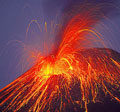 Back in April, when Eyjafjallajökull in Iceland was erupting and causing much disruption to air travel in Europe and the North Atlantic, there was some concern that the volcano’s ash and aerosols could cause global cooling. As I said at the time, there was little chance of that happening because volcanoes need to be near the equator to cause global cooling events. However, we now we have an eruption in Indonesia that has the potential to cause a noticeable global cooling. Merapi is Indonesia’s most active volcano, and the eruptive sequence which began at the end of October has already killed at least 153 people and emitted a considerable amount of sulfate aerosols as this NASA Earth Observatory image shows:
Back in April, when Eyjafjallajökull in Iceland was erupting and causing much disruption to air travel in Europe and the North Atlantic, there was some concern that the volcano’s ash and aerosols could cause global cooling. As I said at the time, there was little chance of that happening because volcanoes need to be near the equator to cause global cooling events. However, we now we have an eruption in Indonesia that has the potential to cause a noticeable global cooling. Merapi is Indonesia’s most active volcano, and the eruptive sequence which began at the end of October has already killed at least 153 people and emitted a considerable amount of sulfate aerosols as this NASA Earth Observatory image shows:

At the time of writing the eruption was showing signs of easing off, and the amounts of sulfur emitted to date haven’t been sufficient (or reached high enough altitudes) to cause a significant cooling. However, as Jeff Masters notes, Merapi’s volcanic history indicates that it is capable of very powerful eruptions which could mimic or exceed the Pinatubo eruption in 19941991 which caused a 0.5ºC cooling over the following 18 months. As ever, the best place to follow events is at vulcanologist Erik Klemetti’s Eruptions blog (note: new web address). Definitely one to watch.

Excellent point about the importance of an equatorial location for the eruption, Gareth. Do we know how big this eruption is yet, compared to Pinatubo? In conjunction with a waning La Nina, this definitely has the potential to mask Climate trends in the short term.
The EO says: “But as of early November, Merapi had emitted just 1 percent of what was released by Mount Pinatubo in 1991.” No risk of anything other than local effects so far. The sulfur hasn’t been punched up into the stratosphere either, so it will be “washed out” of the troposphere relatively quickly. For more on volcanic effects on climate, Weather Underground has a good page here.
Thus far the Merapi eruption is much smaller than Pinatubo, Dodger. Pinatubo had an erupted volume of around 7.5 km3, and was VEI 6 (Volcanic Exposivity Index, a measure of the magnitude and intensity of an eruption). This recent Merapi eruption has been estimated as VEI 3-4, with erupted volume of around 0.15 km3.
“…the Pinatubo eruption in 1994 which caused a 0.5ºC cooling over the following 18 months.”
A glittering career as an IPCC report-writer awaits.
Ha! Fixed. In my defence, it was late.
A small clarification is needed concerning the climate impact of volcanic eruptions as a function of latitude.
The magnitude of the climate impact of a volcanic eruption is determined by the amount of sulfur dioxide injected into the stratosphere where sulfate aerosols form resulting in short duration cooling (http://en.wikipedia.org/wiki/Stratospheric_sulfur_aerosols). All other factors being equal, eruptions at low latitudes have to be more powerful to inject gas into the stratosphere than eruptions at high latitudes because the tropopause rises from less than 10 km at the poles to more than 15 km near the equator. Thus,while it is true that sulfur dioxide injected into the stratosphere in equatorial areas may more easily spread into both hemispheres making any cooling effect truely “global”, a less powerful volcanic eruption at high latitudes could effect one hemisphere to an equal or greater degree.